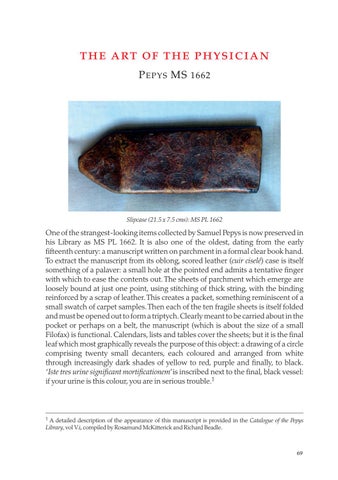the art of the physician P EPYS MS 1662
Slipcase (21.5 x 7.5 cms): MS PL 1662
One of the strangest-looking items collected by Samuel Pepys is now preserved in his Library as MS PL 1662. It is also one of the oldest, dating from the early fifteenth century: a manuscript written on parchment in a formal clear book hand. To extract the manuscript from its oblong, scored leather (cuir ciselé) case is itself something of a palaver: a small hole at the pointed end admits a tentative finger with which to ease the contents out. The sheets of parchment which emerge are loosely bound at just one point, using stitching of thick string, with the binding reinforced by a scrap of leather. This creates a packet, something reminiscent of a small swatch of carpet samples. Then each of the ten fragile sheets is itself folded and must be opened out to form a triptych. Clearly meant to be carried about in the pocket or perhaps on a belt, the manuscript (which is about the size of a small Filofax) is functional. Calendars, lists and tables cover the sheets; but it is the final leaf which most graphically reveals the purpose of this object: a drawing of a circle comprising twenty small decanters, each coloured and arranged from white through increasingly dark shades of yellow to red, purple and finally, to black. ‘Iste tres urine significant mortificationem’ is inscribed next to the final, black vessel: if your urine is this colour, you are in serious trouble.1
1
A detailed description of the appearance of this manuscript is provided in the Catalogue of the Pepys Library, vol V.i, compiled by Rosamund McKitterick and Richard Beadle.
69














